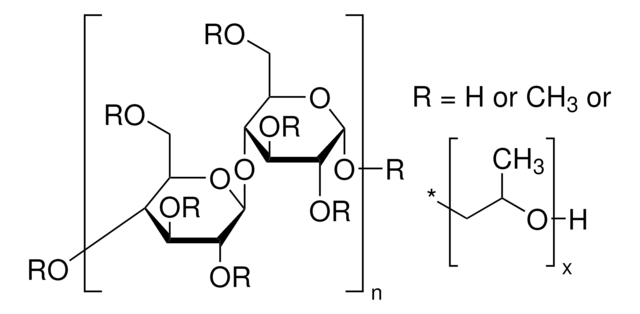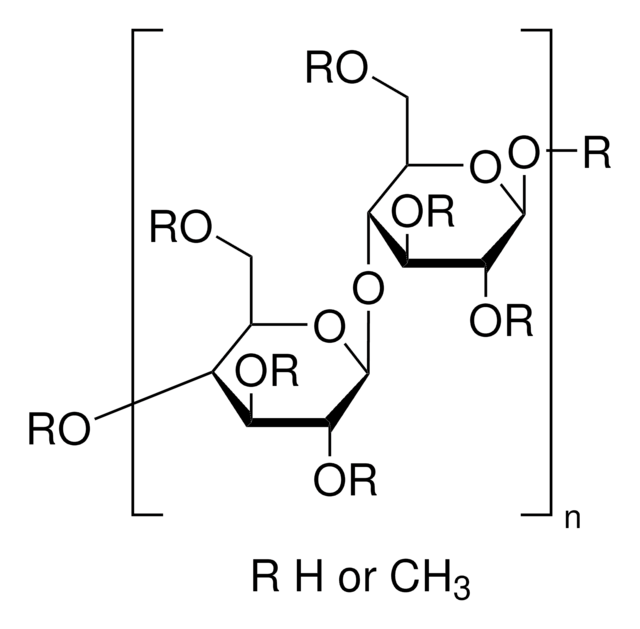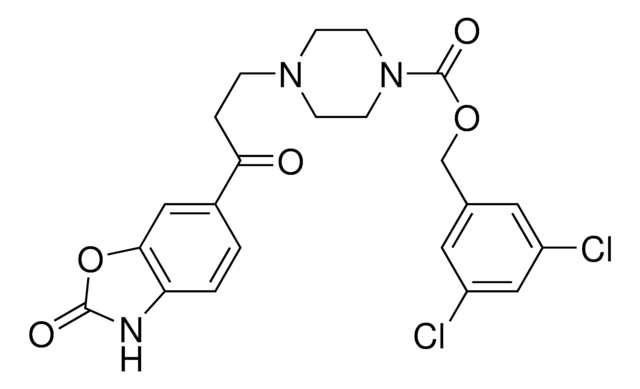推薦產品
形狀
powder
分子量
~22 kDa
顏色
beige
黏度
40-60 cP, 2 % in H2O(20 °C)(lit.)
溶解度
water: 10 mg/mL, clear to slightly hazy
儲存溫度
room temp
SMILES 字串
O3[C@H]([C@@H]([C@H]([C@@H]([C@H]3COCC(O)C)OCC(O)C)OCC(O)C)OCC(O)C)O[C@@H]4[C@H](O[C@H]([C@@H]([C@H]4OCC(O)C)OCC(O)C)OCC(O)C)COCC(O)C.O1[C@H]([C@@H]([C@H]([C@@H]([C@H]1COC)OC)OC)OC)O[C@@H]2[C@H](O[C@H]([C@@H]([C@H]2OC)OC)OC)COC
InChI
1S/C36H70O19.C20H38O11/c1-19(37)9-45-17-27-29(47-11-21(3)39)31(48-12-22(4)40)34(51-15-25(7)43)36(54-27)55-30-28(18-46-10-20(2)38)53-35(52-16-26(8)44)33(50-14-24(6)42)32(30)49-13-23(5)41;1-21-9-11-13(23-3)15(24-4)18(27-7)20(30-11)31-14-12(10-22-2)29-19(28-
InChI 密鑰
PUSNGFYSTWMJSK-GSZQVNRLSA-N
尋找類似的產品? 前往 產品比較指南
應用
特點和優勢
品質
準備報告
在热水中分散:
1. 将约1/3所需量的水加热至最低90 oC。
2. 将粉末加入到热水中,并伴有搅拌或晃动。
3. 晃动混合液直至颗粒完全湿润并均匀分散。
4. 将剩余的水(冷水)加入以降低分散液的温度。随着温度的下降,会达到使其变成水溶性的温度。此次将会开始水化和溶解,提高溶液的粘度。
5. 在达到溶解度的合适温度后持续晃动至少30分钟。此时溶液便可进行使用。
干拌:
1. 将粉末与其他干燥成分混合。干粉与羟丙基甲基纤维素的建议比例在7:1到3:1之间。
2. 将干燥的成分进行充分的搅拌。
3. 将干燥的混合物加入到水中并晃动。
4. 持续晃动直到完全水化并且溶液达到了稳定的顺滑状况。此时溶液便可进行至下一步或使用。
在非溶剂介质中分散
1. 羟丙基甲基纤维素可分散在非溶剂介质中,如植物油、聚乙二醇、甘油、玉米糖浆和浓盐溶液。推荐使用5-8份的非溶剂与1份羟丙基甲基纤维素的比例以获得液体浆料。
2. 晃动混合液直至颗粒均匀分散。
3. 可将分散物加入至冷水中,或将冷水加入到分散物中。
4. 持续晃动直到粉末完全水化并且溶液达到了稳定的顺滑状况。此时可将更多的成分加入到配方中。
儲存類別代碼
11 - Combustible Solids
水污染物質分類(WGK)
WGK 1
閃點(°F)
Not applicable
閃點(°C)
Not applicable
個人防護裝備
Eyeshields, Gloves, type N95 (US)
客戶也查看了
我們的科學家團隊在所有研究領域都有豐富的經驗,包括生命科學、材料科學、化學合成、色譜、分析等.
聯絡技術服務


